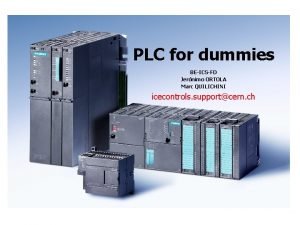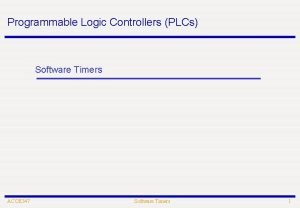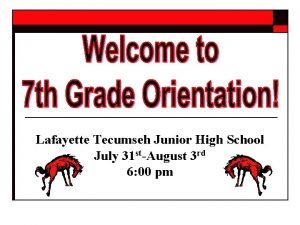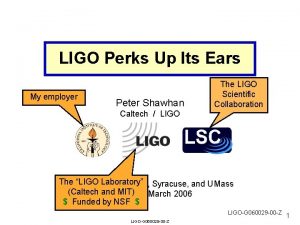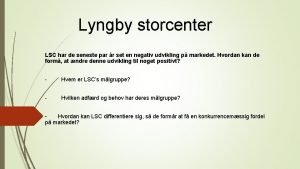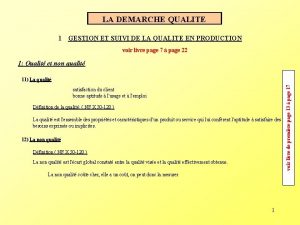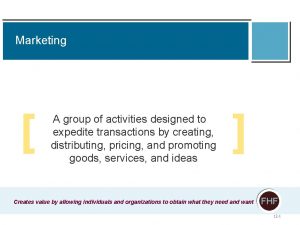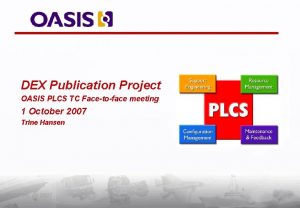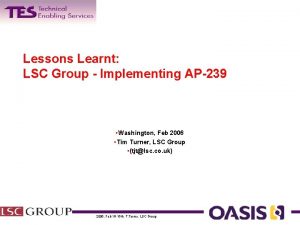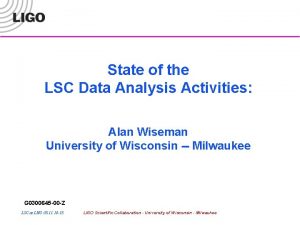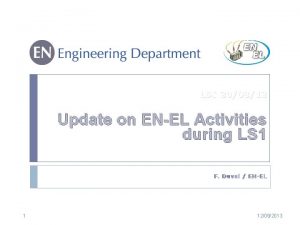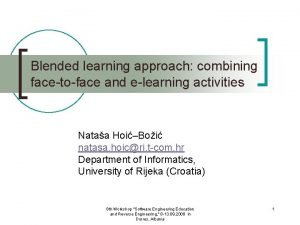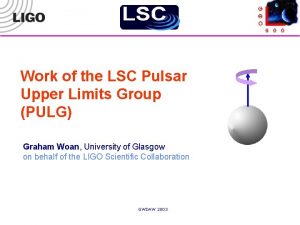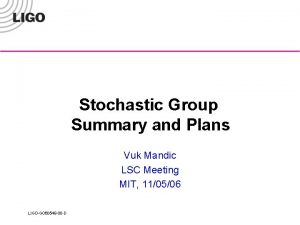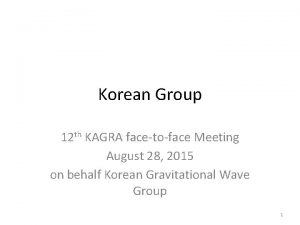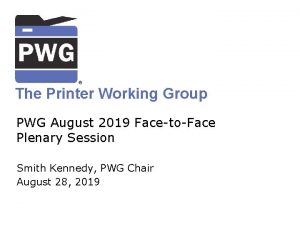PLCS FacetoFace LSC Group Lessons from PLCS Activities

















- Slides: 17

PLCS Face-to-Face: LSC Group – Lessons from PLCS Activities Huntsville, Oct 2006 Tim Turner, LSC Group

LSC Projects • • RB 199 Prototype Demonstrator- Asset Mgt Work Package Management – UMMS (v 1) Configuration Management – SDD & VMP TDP – Technical Datum Pack handover Def Stan 00 -60 – LSAR Mapping for UK Mo. D Contractor Logistic Support: Electronic Logbook Smart Codification Lean Logistics Model

LSC Projects • RB 199 Demonstrator- Asset Management – 1 st PLCS prototype. RR&Mo. D(RAF) Sync Asset+CM+Tech Pubs. In-service exchange of fault report & feedback to improve history recording, acc. & speed of tasks for maintenance activities. • Work Package Management V 1 - UMMS – Exchange work spec between operator & (privatised) dockyards • Configuration Management – SSD – VMP – Exchange CM between operator & (privatised) dockyards • TDP handover: Product Info Explorer – Consistent independent view over many TDP parts/formats; Links AP 203/239 i. e. PLCS view links prod struct to 3 D, LSAR, Tech Pubs & recently Electrical AP 212 • Def Stan 00 -60 – LSAR Mapping for UK Mo. D – Mapped all LSAR elts >500 DED to PLCS. Similarity wth 1388 -2 B • Contractor Logistic Support: Electronic Logbook – Olympus Marine Gas Turbines. Moving from spares only ->Total Care Package. GTCU+CM+Life. History+Feedbk -> Lifing follws item. Operator free of supplier s/w. Component of digital ship; On trial at HMS Sultan • Smart STEP Codification – Open source tools to consistently add/extract catalog data from step files. UK & US NCB, ECCMA CTC, NIST & LSC developing SSC with industry partners. • Lean Logistics Model

Lean Logistics Model – LLM CRP Po. C Background: • Many independently developed logistic processes and systems evolved to meet single Service requirements Purpose: • DLO needs a view over these system applications – evaluate performance (e. g. asset availability) across the enterprise Challenge: • Different generations of IS – Holding a wealth of logistics data locked in many IS stove-pipes - in different proprietary formats – Increasingly provided by industry in both acquisition and in-service. Need: • Open standards based logistics system integration to create a coherent data repository as the basis for improved E 2 E business workflow and management – Automation; Standardisation; E 2 E; Auditable – Filtering; Exception reporting; Decision support; Through Life Management Solution: • AP-239 as central repository to gather data from 10 donor systems using PLCS adaptors as required • Tied PLCS integration with a Collaborative Working Environment to support workflow & business process intelligence • Demonstrated onsite at Mo. D & Bath STEP meeting 2005

Current – Future Context the enterprise performance dashboard e. g. asset availability = 75% analysis driven by business intelligence approaches with a common information model for enterprise integration "cloud of magic transformation" stove-piped data sources manual transfer of data from various sources into various analysis tools - extensive human intervention to resolve meaning of source data stove-piped data sources


CRP Mo. D Foxhill Feb to May 2005 • Demonstrated 1 yr of activity across 4 sessions over the day; intro faults, feedback, repairs, redesign etc. . -> availability of product • 220 attendees (var. ranks CDL & DCDL, CDP & DCDP, DLO 2/*s, – 211 Directors from ADs/DDs/IPTLs/Desk Officers) • Feedback from Questionnaires: Specifically, what potential benefits can be envisaged from adoption of the LLM? – “Better informed decision-making. Reduction in costs. Delivery of capability” – “Managing new contracts and workflow/ project management in an endto-end environment” – “Will make TLMP easier” – “Support proper market (supplier) management” – “Better sparing information for future project procurements” – “Benefit is the ability to view different systems in a coordinated and integrated fashion” • Do you see potential “value add” from adoption of an integrated nonproprietary repository: – A. Yes 98. 5% : No 0% : Not Sure 1. 5%

Lessons learned • AP 239 mapping – well-defined input information & a holistic view of all of the data elements to be mapped are essential, prior to commencement of any PLCS mapping activity, to allow the efficient development of the conceptual PLCS information model to meet business needs • Enterprise Repository – Oracle object-relational database • Object Relational schema directly from the PLCS long form • Unsupported multiple inheritance from the AP 239 schema • EXPRESS STRING limited to VARCHAR 2 – name & id = 255 (else huge overhead) – all other fields = 4000 • added common base type – unique identifier & source database identifier attributes – support for EXPRESS SELECT type

Lessons learned • Enterprise Repository – Added table to map long names • Oracle limit of 32 characters (AP 239 schema includes longer names) – Used de-normalized tables for each business object in the mapping • OASIS Capability business objects – e. g. ‘item of production’, ‘item of supply’ and ‘asset’ • Mapping used (own) templates -> – feedback to OASIS architecture • Data integration – a common reference data library is required to correlate data from different systems to allow consistent reporting of integrated data & the ability to analyse such things as cause & effect relationships between data in disparate systems – the data element "explosion" between source system data elements & their instantiation in the PLCS schema in the context of very large data sets had an impact on data integration performance. Multi-threading processes & the use of de-normalised layers in the database architecture gave significant performance improvements – quality of donor system data is evident -> cleansing rules

Conclusions • AP 239 suitable for scope of business domain • AP 239 suitable as an enterprise integration model • Implementation challenges are not intractable

END Background Slides Follow

Asset Management • RB 199 Tornado Fast Jet Aircraft Demonstrator • Synchronise Asset, CM+Tech Pubs -> improved acc. & speed of tasks for maintenance activities. • Rolls Royce, RAF, CITIS. • Gave first confirmation of PLCS Deliverables • Exchange of in-service configuration, maintenance tasks, feedback of engine fault data, design change, new work instructions, new part and permissable configuration

Work Package Management • Unit Maintenance Management System (UMMS) • UMMS – Implements principles of Reliability-Centred Maintenance (RCM) in UK Navy – Inc. UMMS Aboard (ship-based maintenance at sea) & shore-based system • Allows Navy to gather info across fleet • Challenge: – UK Government no longer own a dockyard with capabilities to perform repair & overhaul of Navy vessels, and – Privatised dockyards operate independent work planning systems – Hence Mo. D face data exchange problem with each dockyard used. • Prime PLCS target – LSC has produced a capability to generate Work Packages in AP 239 format to use with yards.

Configuration Management - VMP • Challenge: – Mo. D using Submarine Definition Database (SDD) – Dockyard using Vessel Material Planning system (VMP) • LSC verified PLCS supports all necessary capability to represent the Master Configuration Record of a submarine • AP 239 can also represent the complex Fleet Area code – Code is a hybrid of product structure, using physical, zonal and system elements

TDP Handover Framework for Interoperability • Prime contractor delivers complex asset to owner, plus large amount of support information (in many formats). • Huge challenge for owner to gain consistent view across the complete & varied data set. • Product Information Explorer (PIE) demonstrated that PLCS has the capability to provide an integrated view across the TDP items and sources. • Included integration of AP 203 & AP 239 for linking 3 D geometry to – Product structure, LSAR, Tech Pubs • Recently integrated AP 212 for electrical routing and device information • Info is presented in context of defined product structures – allows easy & consistent method of access to wide breadth of data (e. g DB’s, spreadsheets, text files, xml files, Step files etc. . • Such a range is necessay for typical complex asset

Def. Stan 00 -60 Mapping • 00 -60 – Specifies the Logistic Support Analysis Record (LSAR) – a derivative of 1388 -2 B – Provides mechanism for extensive definition of Support Solutions, including; – identification of LSI within product – specification of apropriate tasks to maintain product – LSC mapped all elements of the LSAR (> 500 DED) to relevant ones in AP 239 for Mo. D – May also be basis for integrating support engineering into wider enterprise context • E. g. enables Mo. D to view total set of LSAR’s for all acquisition projects • Also enables Integrated Project Teams (IPT) to import LSAR into other AP 239 compliant applications (e. g. PDM or ERP).

Electronic Logbook Contractor Logistic Support: PLCS important role when asset owners rely upon contractors for logistic support • Context: Marine Gas Turbine Supplier moving from traditional spares support to a total-care-package. • GTCU+CM+History -> Equipment Health Monitoring • Component of digital ship; – – – – – • Supplier needs the CLS contract to run efficiently AP-239 able to replace current physical collection of information accompanying engine PLCS provides Product Configuration Information, allows history/life info storage Equipment fitted to slots in the structure; can be removed/refitted as required. Each operation recorded. Removed item carries own usage info with it – to next location. Parent carries record of which equipment fitted, when fitted & how much usage consumed while fitted Owner gets access to product support info without being tied to supplier’s software Contractor gets access to product feedback which helps to provide approp. support Typically 4 turbines per ship Prototype On trial at HMS Sultan (RN MES)
 Plcs for dummies
Plcs for dummies Plcs
Plcs Indoor and outdoor sports examples
Indoor and outdoor sports examples Tecumseh middle school dress code
Tecumseh middle school dress code Proportional systematic error
Proportional systematic error Lonestar nursing prerequisites
Lonestar nursing prerequisites Lsc perks
Lsc perks Lsc lyngby
Lsc lyngby Lsc environmental products, llc
Lsc environmental products, llc Capabilité machine exemple
Capabilité machine exemple Operating activities vs investing activities
Operating activities vs investing activities Primary and support activities
Primary and support activities Primary and secondary activities
Primary and secondary activities Existential group therapy activities
Existential group therapy activities A group of activities designed to expedite transactions
A group of activities designed to expedite transactions Lord of the flies group activities
Lord of the flies group activities Frustration aggression principle
Frustration aggression principle Y = a(b)^x
Y = a(b)^x
